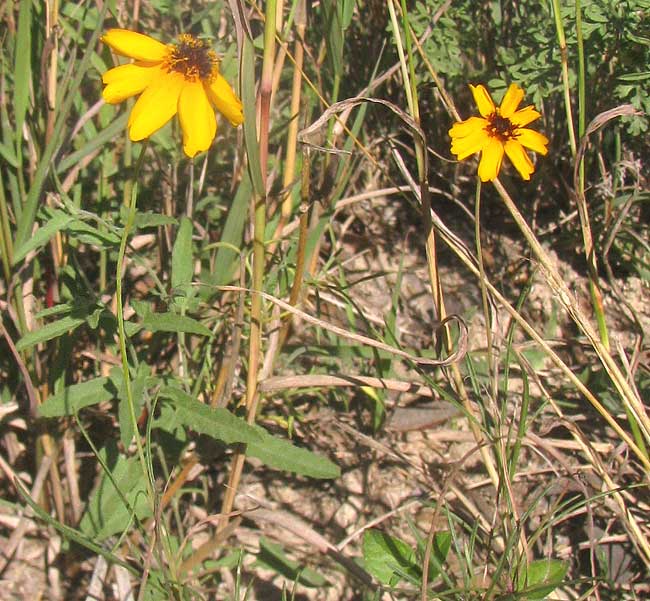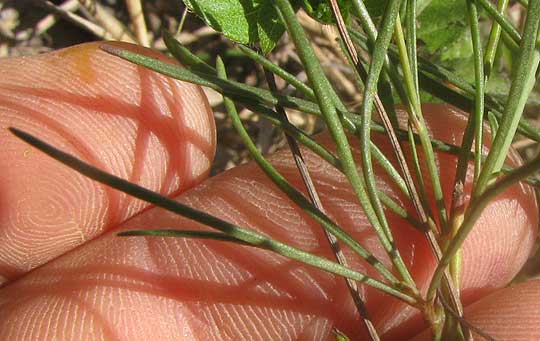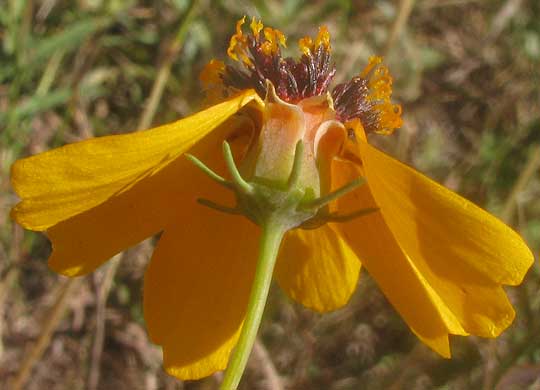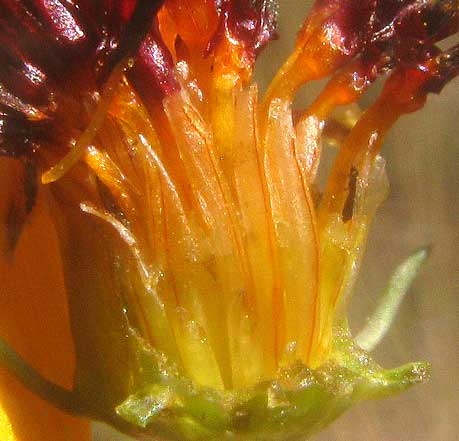Excerpts from Jim Conrad's
Naturalist Newsletter

from the November 10, 2013 Newsletter issued from the Frio Canyon Nature Education Center in the valley of the Dry Frio River in northern Uvalde County, southwestern Texas, on the southern border of the Edwards Plateau; elevation ~1750m (~5750 ft); N29.62°, W99.86°; USA
STIFF GREENTHREAD
In our arid environment with low, scrubby forests giving way to prairie patches, members of the Composite or Sunflower Family constitute a huge part of our wildflower population. It's hard to remember which is which. Thus the other day I wasn't sure if I'd ever seen the yellow-rayed composite turning up in grass along a weedy roadside, shown above.
Note that the heads stand atop long, slender, leafless stems, or peduncles. Compound leaves with very narrow segments cluster toward the plant's bottom. Below, you can see those basal, threadlike leaves:

We've had yellow-rayed composites with such leaves before. Hoping to see something more determinative, I removed two petal-like ray flowers from a head to give a view of the scaly, bowl-like involucre below the flowers. What I saw was unusual, but I'd seen it before. It's shown below:

Usually a composite head's involucre consists of numerous scales overlapping one another like roof shingles, or maybe they're slender and aligned side-by-side, and typically the scales are very similar to one another. Here eight slender, green items poke from the involucre's base, then above them there's a series of very broad, colored, overlapping scales surrounding the head's yellow ray flowers and blackish disc flowers. This is very unusual, but we've seen it.
A view of the disc flowers' bases shows that each base is partly enveloped by an orangish, scoop-like scale, seen below:

The thing is, in gross aspect, the plant on which we've seen this kind of crazy-looking involucre looked very different from our present roadside one. You can see our previous species with such an involucre at http://www.backyardnature.net/n/h/thelespe.htm.
That's the Slender Greenthread, which we saw back in July hanging on a limestone ledge. On that page the third picture shows an involucre very much like this week's roadside species. The Slender Greenthread is Thelesperma simplicifolium. Our new plant also is a greenthread and a member of the genus Thelesperma, in wildflower books called Stiff Greenthread. It's THELESPERMA FILIFOLIUM, described by the Flora of North America as occupying disturbed sites on clays or sandy soils and rocky slopes, often on limestone, from southern South Dakota south through the US south-central states into arid northeastern Mexico.
Traditionally, several greenthread species have been used as teas by America's indigenous people, and sometimes are known as Navajo Tea, Hopi Tea, or just Indian tea. Both our Stiff and Slender Greenthreads are among those used as teas. A well illustrated page showing greenthreads cultivated for tea use and packaged for sale, as well as a discussion of the plants' medicinal properties, is at http://www.itmonline.org/arts/greenthread.htm.